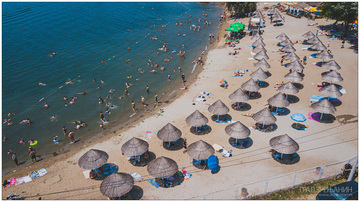Banat ethno

Clothing
Banat folk costume
The basic Banat folk costume consists of the shirt and "drawers", or breechless-like Serbian peasant trousers, and their style, materials, and technique of workmanship are of ancient Slavic origin. The names: platno (linen), sukno (cloth), tkanje (weaving), rubača (head scarf), rub (seam), are encountered in all the Slavic languages, hence they are of Proto-Slavic origin. The same applies for the names: nogavice (legs), ručnik (towel), opanci (Balkan moccasins), plašt (mantle), vuna (wool), gaće (drawers).... The actual materials (flax, hemp) and the way of workmanship indicate that such clothing became the folk costume of farmers. That is the basis of Banat folk costume and, in that pure form, it is of Pannonian Scythian type, while the golden embroidery that appears on aprons and sleeveless jacket of the female folk costume indicates the oriental influence.
The folk costume disappeared from the everyday use already by the end of the 19th century, specifically firstly among the Serbs. However, one part of female folk costume – the headgear – a golden cap with two long strips decorated with small gems, pearls, and spangled, was preserved as the symbol of prestige up to the end of the first decade of the 20th century. It was worn by brides and just married women from well-to-do peasant households. For the wedding, it was procured by the groom’s household. In the entire Banat there were quite a lot of women embroiderers who charged cereals or money for their work. The most demanded among women embroiderers was Kata Lončarski, called "Zlatarka-Golden", from Melenci, whose two daughters were also skilled embroiderers. Kata, after whom Lončarski family got the nickname ("špic name") "Zlatarov-Goldsmith’s", in 1884, won the First Class award in Novi Sad and in Budapest in 1896, for handmade clothes embroidered with gold threads.
On needleworks from these areas that decorated various clothes and household objects, various floral motives were predominantly used as ornaments. Flowers of different sizes, and mainly light and with lots of colors (Baroque influence), are matched in a certain ornamental pattern.
 Skupstinagrada Zrenjanina
Skupstinagrada Zrenjanina